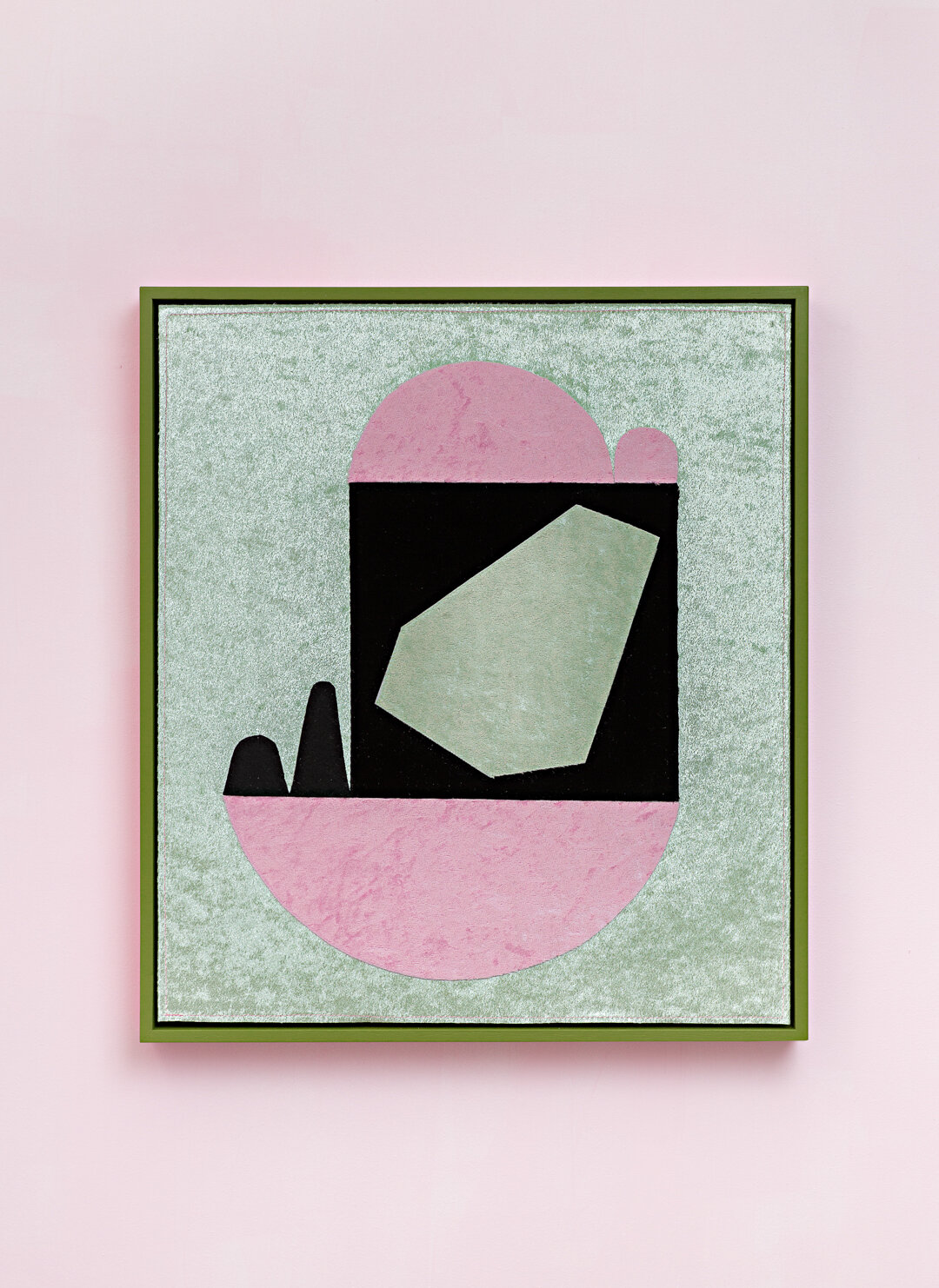TELEPATHIC LOVESONG 2021
Galerie Pompom, Sydney
Photography by Document.
Telepathic Lovesong.
Velveteen, Ali Noble’s medium of choice, presents itself in an unfixed manner. Shade, depth and tone shapeshift and shimmer depending on the light conditions and the viewing angle. As the audience, we are compelled to take our time exploring these works and their unsteady state. Not just an ocular interaction, our physical presence in this shared space takes on greater significance. The lure of tactility transfers into a performative state, as bodies carry eyes around the room, and hands long to touch.
The framed works in Telepathic Lovesong might first speak to the viewer as paintings through their scale and form. However, textiles resonate differently, more subconsciously than paint. Fabric lives with us, moves with us, it shields, reveals, contains and recalls. Its tactility can be alluring, comforting, sensuous, therapeutic, repellent. As Noble has noted, from the first time we are swaddled as a baby, textiles are intrinsic to our lives in the world. Cutting and sewing fabric are tactile and performative processes steeped in agency and control.
Noble’s velveteen scenes have a considered simplicity yet are far from flat. Inset rectangles, and the artist’s recurrent use of a symbolic vocabulary of curved, scalloped and teardrop shapes in a variety of sizes, draw the eye into and between these compositions, allowing the brain to invent animal, vegetable and mineral forms inhabiting the abstract. Pastels, too, conjure a myriad of associations, their kitsch further enriched by the crushed velveteen texture. Fairy floss pink and soft, mint green convey an optimistic, decorative impression, while dramatic black forms draw the viewer into the picture plane.
Velveteen is named after its rich ancestor velvet, but the two are quite different. Velvet, with its serious, regal overtones, sucks the light out of the atmosphere, into folds of opacity. Velveteen on the other hand flickers and glints as the viewer’s point of view changes, light dancing in and out of the crushed pile. The largest work in Telepathic Lovesong, Waiting Room, is an expansive expression of these scintillating, camp qualities, in the form of a dramatic silver curtain drawn across the gallery.
Curtains and drapery have been a familiar presence in art history for millennia, as a protective layer for paintings, and as a way for an artist to display a technical flourish. Functionally and dramatically, the curtain is where textiles paradoxically control and are controlled. Beyond the visual arts, the curtain’s role ranges from the dramatic to the quotidian. Whether drawn across the proscenium arch of a theatre or dividing a hospital ward, it cuts us off from what is behind, temporarily suspending belief.
Love, wonder, care, grief and longing are eternal elements of the human condition, even as that human condition is subject to technological advances, and existential threats. Creative and communicative impulses are a manifestation of our journey through this condition. What can be made of Noble’s slowed-down, hands-on, contemplative approach to her work in a screen-focussed, socially-distanced, sped-up world? While the warp and weft of the loom was an early ancestor of modern computing, the fundamental qualities of textiles remain antithetical to that of the screen.
As we have all spent time in the pandemic waiting room, a weird tension has emerged between deflation and inflation, with artworks seeming to get flatter, while their market value soars higher. In that virtual world, it doesn’t matter that we are temporarily unable to stand inside a gallery. The curtain, and the mystery it affords, is a relic. The emperor has no clothes, all that remains visible are his bits, and bytes. For some, the pandemic pivot simply shifts a jet-set pace to the online space. In the world of Telepathic Lovesong, it means something different. Time spent caring, time spent looking through drawn curtains. Not scrolling, but pausing to notice the mysterious ways materials and people communicate. Sometimes, pivoting means arriving, 360 degrees later, back where you started. In a room shared with objects and people, doing a shuffle-dance between shimmering artworks, attempting to decode their signs and symbols, free to move both feet any way you like.
Chloe Wolifson, 2021









